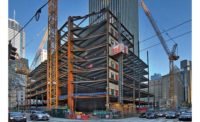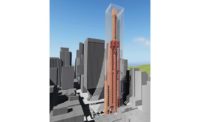Contractors, Steel Firms Blast Mighty Earth Report on 'Dirty' Structural Steel
Environmental advocacy group Mighty Earth’s call to action to reduce the carbon footprint of structural-steel production is well intended but naive, say construction and steel-sector firms.
“The analysis greatly oversimplifies the steel-making process and the ability of participants in the supply chain to adapt to the proposals outlined,” says David Zalesne, president of steel fabricator Owens Steel and 2018-19 chair of the American Institute of Steel Construction.
Sources who declined to be named also object to the title of the 10-page report, “Construction Destruction: The Hidden Carbon Costs of Dirty Steel,” calling it sensational. The report’s cover photo, which depicts razed reinforced concrete, also is off base, they say.
“I am hesitant to give this report too much credibility,” says Zalesne. Another source calls the report, sponsored by the Center for International Policy, a nongovernmental organization, “a guerilla tactic by a startup NGO.”
After giving a nod to advancements in energy efficiency by U.S. steel mills, which use more than 90% recycled material in production, the report says there is still “an urgent need for further progress in emission reductions, both domestically and abroad,” but offers no road map except to suggest a shift from fossil fuels to renewables for power needs. It then identifies steel producer Nucor Corp. as “best-positioned to switch to 100% clean energy for its electricity.”
Katherine Miller, Nucor’s director of public affairs, counters that every ton of Nucor steel made using more efficient electric arc furnaces prevents some 215 tons of greenhouse gas emissions that would occur if that same ton were made in China, where mills charge less for structural shapes.
“Energy-intensive manufacturers … require a steady, reliable and cost-effective level of baseload power generation,” says Miller. Given current technology and baseload power needs, it is not feasible to run a mill solely with renewables, she adds.
The report also challenges construction firms. Turner Construction, Clark Construction Group and AECOM, “the top three green building contractors collectively have a green design revenue of $13.36 billion,” says the report. None of these has “committed to only buying materials with the lowest possible global warming potentials.” In addition, Bechtel Corp. and Fluor Corp.—the largest construction companies in the U.S.—have “not made any public efforts to address their projects’ embodied carbon,” states the report.
These companies should work to achieve industrywide commitments, which include requiring all steel makers and fabricators “to publish facility-specific” environmental product declarations, the report says.
“We chose contractors already doing some good,” says the principal author, Margaret Hansbrough, director of Mighty Earth’s Stainless: The 100% Clean Energy Steel Campaign.
A Clark spokesperson says the firm works “with a diverse network of qualified and respected fabricators. As part of this complex supply chain process, the firms work closely with steel distributors to ensure they meet clients’ objectives.”
The report spares building owners and designers, but “development companies and/or end-use clients and architect and engineering teams will need to be part of solving this challenge,” says Hansbrough.




